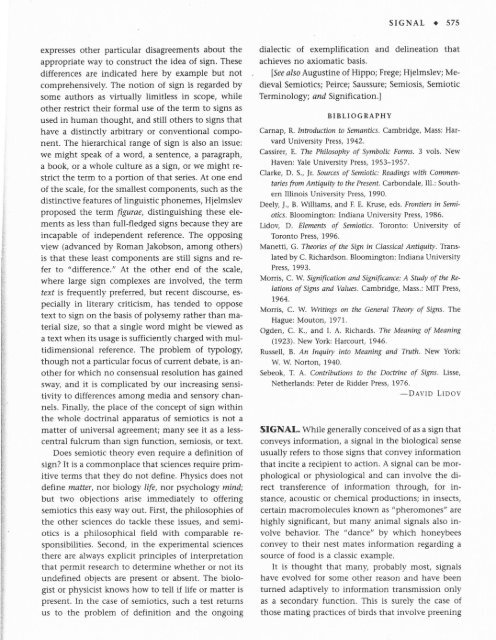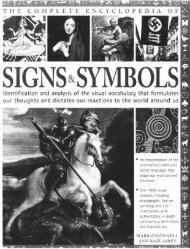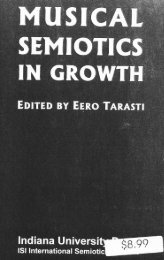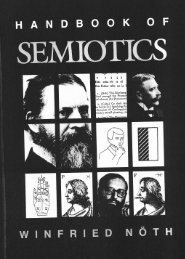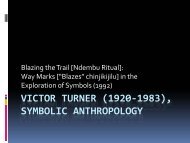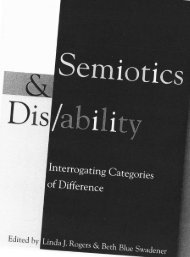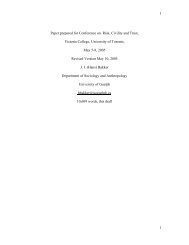Encyclopedia of Semiotics - SemioticSigns.com
Encyclopedia of Semiotics - SemioticSigns.com
Encyclopedia of Semiotics - SemioticSigns.com
You also want an ePaper? Increase the reach of your titles
YUMPU automatically turns print PDFs into web optimized ePapers that Google loves.
SIGNAL<br />
'<br />
575<br />
expresses other partiolar disagreements about the<br />
appropriate way to construct the idea <strong>of</strong> sign. These<br />
differences are indicated here by example but not<br />
<strong>com</strong>prehensively. The notion <strong>of</strong> sign is regarded by<br />
some authors as virtually limitless in scope, while<br />
other restrict their formal use <strong>of</strong> the term to signs as<br />
used in human thought, and still others to siSns that<br />
have a distinctly arbitrary or conventional <strong>com</strong>ponent.<br />
The hierarchical range <strong>of</strong> sign is also an issue:<br />
we might speak <strong>of</strong> a word, a sentence, a paragraph,<br />
a book, or a whole culture as a sign, or we might restrict<br />
the term to a portion <strong>of</strong> that series. At one end<br />
<strong>of</strong> the scale, for the smallest <strong>com</strong>ponents, such as the<br />
distinctive features <strong>of</strong> linguistic phonemes, Hjelmslev<br />
proposed the term figurae, distinguishing these elements<br />
as less than full-fledged signs because they are<br />
incapable <strong>of</strong> independent reference. The opposing<br />
view (advanced by Roman Jakobson, among others)<br />
is that these least <strong>com</strong>ponents are still signs and refer<br />
to "difference." At the other end <strong>of</strong> the scale,<br />
where large sign <strong>com</strong>plexes are involved, the term<br />
te.xf is frequently preferred, but recent discourse, especially<br />
in literary criticism, has tended to oppose<br />
text to sign on the basis <strong>of</strong> polysemy rather than material<br />
size, so that a single word might be viewed as<br />
a text when its usage is sufficiently charged with multidimensional<br />
reference. The problem <strong>of</strong> typology,<br />
though not a particular focus <strong>of</strong> current debate, is another<br />
for which no consensual resolution has gained<br />
sway, and it is <strong>com</strong>plicated by our increasing sensitivity<br />
to differences among media and sensory channels.<br />
Finally, the place <strong>of</strong> the concept <strong>of</strong> sign within<br />
the whole doctrinal apparatus <strong>of</strong> semiotics is not a<br />
matter <strong>of</strong> universal agreement; many see it as a lesscentral<br />
fulcrum than sign function, semiosis, or text.<br />
Does semiotic theory even require a definition <strong>of</strong><br />
sign? It is a <strong>com</strong>monplace that sciences require primitive<br />
terms that they do not define. Physics does not<br />
define matter, nor biology life, nor psychology mind;<br />
but two obiections arise immediately to <strong>of</strong>fering<br />
semiotics this easy way out. First, the philosophies <strong>of</strong><br />
the other sciences do tackle these issues, and semiotics<br />
is a philosophical field with <strong>com</strong>parable responsibilities.<br />
Second, in the experimental sciences<br />
there are always explicit principles <strong>of</strong> interpretation<br />
that permit research to determine whether or not its<br />
undefined objects are present or absent. The biologist<br />
or physicist knows how to tell if Iife or matter is<br />
present. In the case <strong>of</strong> semiotics, such a test returns<br />
us to the problem <strong>of</strong> definition and the ongoing<br />
dialectic <strong>of</strong> exemplification and delineation that<br />
achieves no axiomatic basis.<br />
[See also Augustine <strong>of</strong> Hippo; Frege; Hjelmslev; Medieval<br />
<strong>Semiotics</strong>; Peirce; Saussure; Semiosis, Semiotic<br />
Terminology; cnd Signification.l<br />
BIBLIOGRAPHY<br />
Camap, R. Introduction to Semantics. Cambridge, Mass: Harvard<br />
University Prcss, 1942.<br />
Cassirer, E. The Philosophy <strong>of</strong> Symbolic Forms. 3 vols. New<br />
Haven: Yale University Press, 1953-1957.<br />
Clarke, D. 5., Jr. Sources <strong>of</strong> Semiotic: Readings with Commentaries<br />
ftom Antiquity to the Prcsent. Carbondale, Ill.: Southern<br />
Illinois University Press, 1990.<br />
Deely, J., B. Williams, and F. E. Kruse, eds. Frontiers in Semi<strong>of</strong>ics.<br />
Bloomington: Indiana University Press, 1986.<br />
Lidov, D. Elements <strong>of</strong> <strong>Semiotics</strong>. Toronto: University <strong>of</strong><br />
Toronto Press, 1996.<br />
Manetti, G. Theories <strong>of</strong> the Sign in Classical Antiquity. Ttanslated<br />
by C. fuchardson. Bloomington: Indiana University<br />
Press, 1993.<br />
Morris, C. W. Signification and Significance: A Study <strong>of</strong> the Relations<br />
<strong>of</strong> Signs and Values. Cambridge, Mass.: MIT Press,<br />
1964.<br />
Morris, C. W. Witings on the General Theory <strong>of</strong> Signs. The<br />
Hague: Mouton, 1971.<br />
Ogden, C. K., and I. A. Richards. The Meaning <strong>of</strong> Meaning<br />
(1923). New York: Harcourt, 1946.<br />
Russell, B. An Inquiry into Meaning and Truth. New York:<br />
W W. Norton, 1940.<br />
Sebeok, T. A. Contributions to the Doctrine <strong>of</strong> Signs. Lisse,<br />
Netherlands: Peter de Ridder Press, 1976.<br />
-Devro Lruov<br />
SIGNAL.<br />
conveys information,<br />
While generally conceived <strong>of</strong> as a sign that<br />
a signal in the biological sense<br />
usually refers to those signs that convey information<br />
that incite a recipient to action. A signal can be morphological<br />
or physiological and can involve the direct<br />
transference <strong>of</strong> information through, for instance,<br />
acoustic or chemical productions; in insects,<br />
certain macromolecules known as "pheromones" are<br />
highly significant, but many animal signals also involve<br />
behavior. The "dance" by which honeybees<br />
convey to their nest mates information<br />
source <strong>of</strong> food is a classic example.<br />
regarding a<br />
It is thought that many, probably most, signals<br />
have evolved for some other reason and have been<br />
turned adaptively to information<br />
transmission only<br />
as a secondary function. This is surely the case <strong>of</strong><br />
those mating practices <strong>of</strong> birds that involve preening


